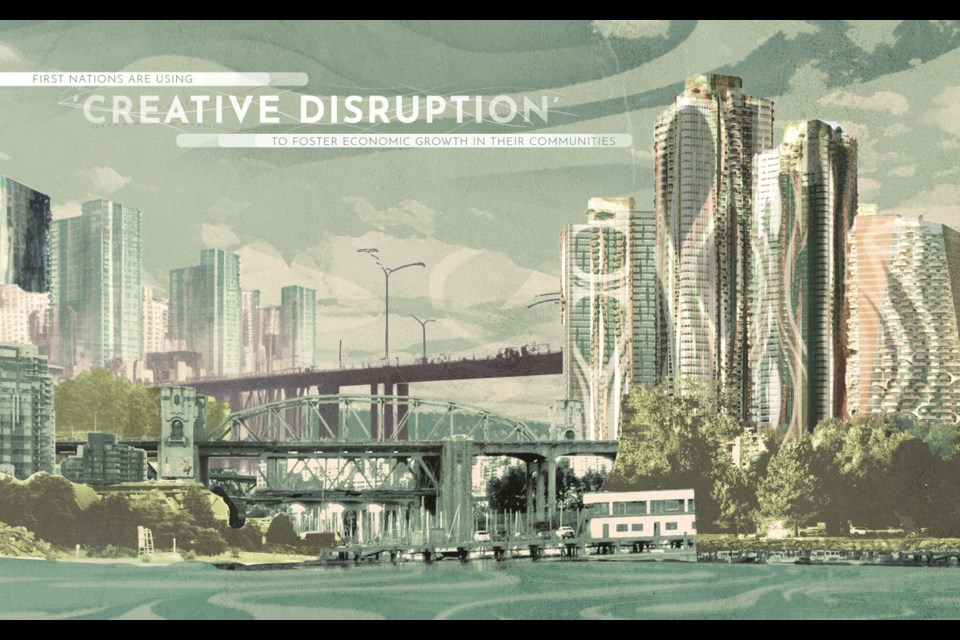First Nations have been resisting the on their communities by exercising and taking control of their economic futures.
Creative disruption stands in contrast to , a term coined by Austrian political economist Joseph Schumpeter. Schumpeter argued that capitalism causes old ideas and technology to quickly become obsolete through the process of innovation. In the pursuit of profit, capitalism ruthlessly and relentlessly eliminates old ideas and installs new ones.
Creative disruption, on the other hand, aims to make space for new ideas by forcing the old ways to adapt and adopt. First Nations communities are doing this in a number of ways.
As an academic with a background in urban land economics, I have studied how First Nations are using creative disruption to shape businesses, urban communities and the health-care system in Canada.
Sen’ák_w development project
One of the ironies of modern Indigenous land law is how the reserve system defined by the Indian Act, originally , has morphed into a strategic asset for First Nations.
As author Bob Joseph notes in , the ¬È∂π…Áπ˙≤˙Nation lost 14 acres (about 0.05 square kilometres) of their territory in Vancouver to a lumber company through expropriation in 1904.
After a century of litigation, the and Sen’ák_w, a massive economic development project in Kits Point, Vancouver.
Sen’ák_w is the largest Indigenous-led housing retail development in Canadian history and will add much-needed housing supply for most. The development plans to build .
Naawi-Oodena urban reserve
A second example of creative disruption is the creation of the in Winnipeg. It’s , covering 64 hectares.
Naawi-Oodena was officially established after the land the reserve sits on—the former Kapyong Barracks—was recently repatriated to .
Treaty One Nation under the provisions of the after the Canadian government tried to transfer the land to a Crown corporation years ago.
After a prolonged legal process, a judge ruled the and the land transfer was ruled illegitimate in 2015.
An incorporated consortium run by the Treaty One Nation, called , will oversee developments on Naawi-Oodena.
As a self-governing nation, Treaty One will set its own land management policies, potentially in contrast to the zoning and building codes of Winnipeg. In reality, it’s likely to gently push or disrupt urban development, rather than outright destroy current practices since its goal is to attract tenants, the majority of which will be non-Indigenous.
First Nations health-care
First Nations entrepreneurs are also seeking out ways to revolutionize the Canadian health-care system. Enoch Cree Nation in Alberta entered into an agreement with contractors to offering simple hip and knee surgeries.
The provincial government will fund the procedures through medicare and publicly funded hospitals will still handle more complicated surgeries.
Enoch Cree Nation joins a growing number of private health clinics in Canada forming public-private partnerships. They are not the first First Nation to get involved with health-care, either.
In 2012, Westbank First Nation . Some constitutional experts , but that, as a self-governing nation, it was not bound by federal laws.
Enoch Cree Nation’s private clinic will face other challenges. While COVID-19 has shaken the faith Canadians have in our health-care system, and , the affinity for public health care remains strong.
Legal redress
First Nations have also become creative disrupters by pursuing legal redress for past injustices. The courts have reached back through treaties all the way back to to widen Canada’s constitution beyond the formal acts to include treaties with First Nations.
Institutional changes supporting disruption include that recognizes the “existing aboriginal and treaty rights of the aboriginal peoples of Canada.” This clause is widely interpreted as creating a nation-to-nation relationship between First Nations and Canada.
Equally important for commercial ventures is which exempts First Nations land from taxation by any order of government. This means an urban reserve does not pay property tax to a municipality.
Despite , Article 87 offers a major fiscal benefit for First Nations individuals and businesses on reserve. Although a complex area of law, this tax exemption is an important reason why First Nations may prefer to add land to existing reserves or to create new reserves, rather than owning land conventionally like corporations.
Furthering reconciliation
Despite some First Nations regaining rights and titles to their lands, Indigenous communities in Canada still . By engaging in the examples of creative disruption here, First Nations are working toward economic prosperity for their communities and, in the process, are also working toward reconciliation.
The ——states Indigenous people have the right to pursue their own means of economic development. By starting their own entrepreneurial and developmental projects, First Nations are engaging in their inherent “right to maintain and develop their political, economic and social systems or institutions.”
Reconciliation also works best when all parties involved benefit from changes. These examples of creative disruption will benefit non-Indigenous Canadians as well as Indigenous people by increasing the housing supply in Vancouver and Winnipeg, bringing remote First Nations into the economic orbit of cities and offering increased health treatment options.
Gregory C. Mason is an associate professor in economics at the University of Manitoba. This article was originally published March 1 on The Conversation, an independent and non-profit source of news, analysis and commentary from academic experts. Learn more at theconversation.com.




